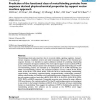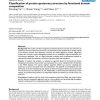BMCBI
2006
14 years 24 days ago
2006
Metal-binding proteins play important roles in structural stability, signaling, regulation, transport, immune response, metabolism control, and metal homeostasis. Because of their...
BMCBI
2006
14 years 24 days ago
2006
Background: Determination of the subcellular location of a protein is essential to understanding its biochemical function. This information can provide insight into the function o...
BMCBI
2006
14 years 24 days ago
2006
Background: Owing to rapid expansion of protein structure databases in recent years, methods of structure comparison are becoming increasingly effective and important in revealing...
BMCBI
2006
14 years 24 days ago
2006
Background: The number and the arrangement of subunits that form a protein are referred to as quaternary structure. Quaternary structure is an important protein attribute that is ...
BMCBI
2006
14 years 24 days ago
2006
Background: The majority of peptide bonds in proteins are found to occur in the trans conformation. However, for proline residues, a considerable fraction of Prolyl peptide bonds ...
BMCBI
2006
14 years 24 days ago
2006
Background: Does a relationship exist between a protein's evolutionary rate and its number of interactions? This relationship has been put forward many times, based on a biol...
BMCBI
2006
14 years 24 days ago
2006
Background: Phylogenetic analyses of protein families are used to define the evolutionary relationships between homologous proteins. The interpretation of protein-sequence phyloge...
BMCBI
2006
14 years 24 days ago
2006
Background: Protein-protein interactions have traditionally been studied on a small scale, using classical biochemical methods to investigate the proteins of interest. More recent...
BMCBI
2006
14 years 24 days ago
2006
Background: That the structure determines the function of proteins is a central paradigm in biology. However, protein functions are more directly related to cooperative effects at...
BMCBI
2006
14 years 24 days ago
2006
Background: Knowledge of the subcellular location of a protein is critical to understanding how that protein works in a cell. This location is frequently determined by the interpr...




